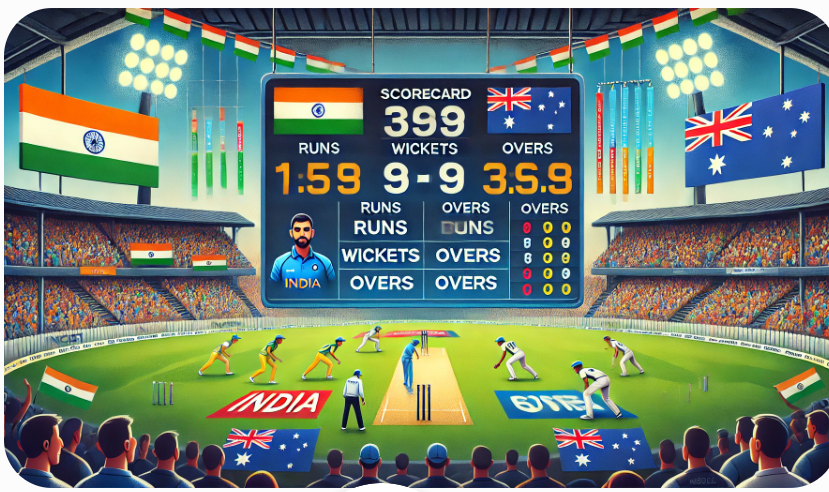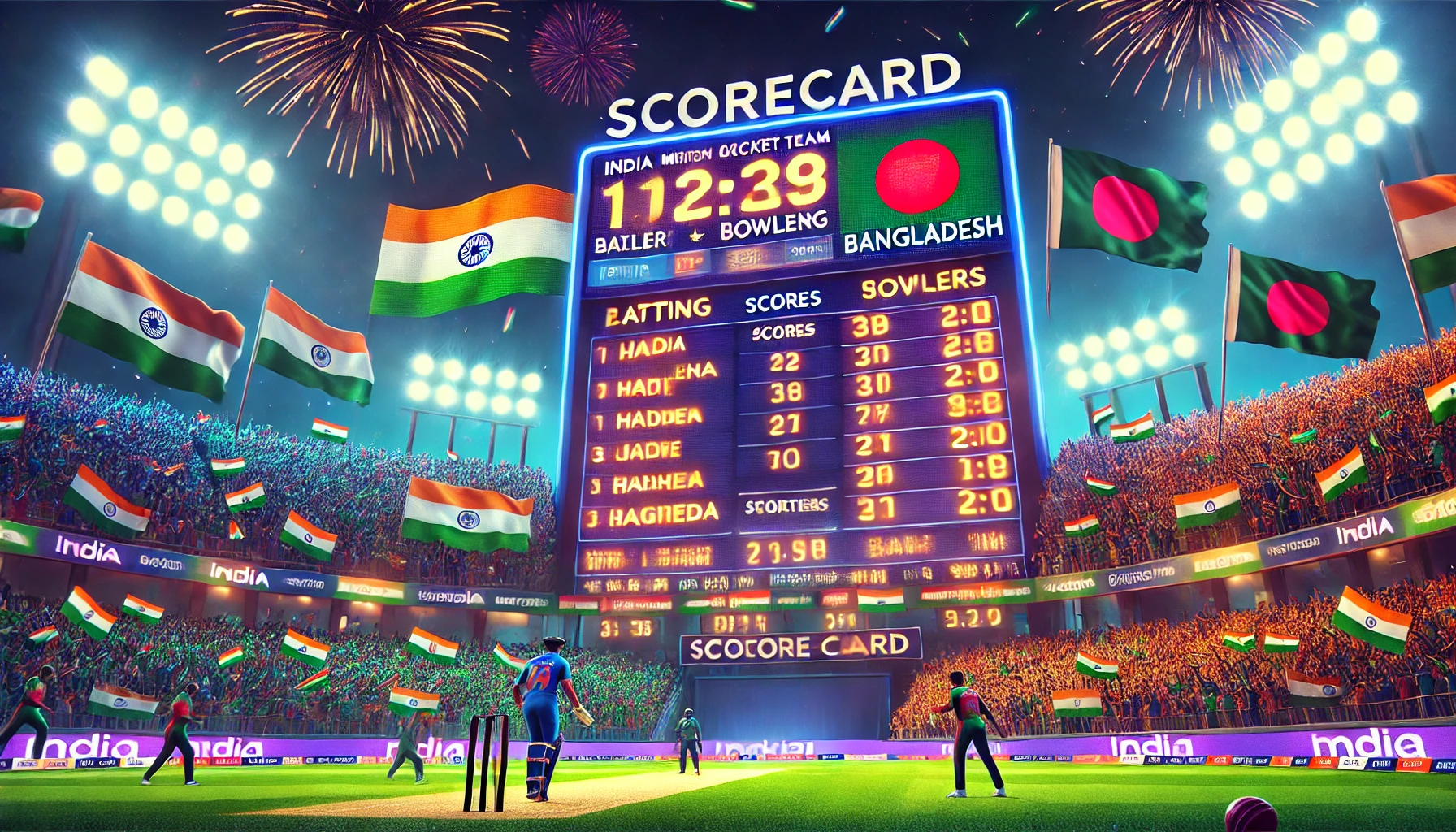Sport
India National Cricket Team vs Australian Men’s Cricket Team: Latest Match Scorecard & Detailed Analysis

When the India National Cricket Team faces the Australian Men’s Cricket Team, it’s more than just a match – it’s a battle of skills, strategies, and rivalries. Both teams boast cricketing icons, historic wins, and competitive spirits that have set high standards in the cricketing world. Their recent encounter left fans at the edge of their seats with every ball bowled and run scored. Here’s a comprehensive breakdown of the match scorecard, the players who shined, and the unforgettable moments that defined the game.
Read more:india national cricket team vs australian men’s cricket team match scorecard
Pre-Match Hype and Strategy
The buildup to an India vs. Australia match is filled with excitement and speculation. For this game, both teams were looking to assert dominance, especially as they prepared with their strongest lineups. With the pitch conditions predicted to favor both fast bowlers and spinners at different stages, team composition and strategy were crucial.
The Toss
Winning the toss gave India the upper hand, and they opted to bat first on a pitch that offered early assistance to batsmen but was expected to deteriorate later in the game. This decision was well-calculated, as a solid score on the board would pressure Australia in their chase.
India’s Batting Performance: Setting a Competitive Total
Opening the innings, Rohit Sharma and Shubman Gill aimed to provide a solid foundation. The opening partnership between these two batsmen started cautiously but soon accelerated, providing India with a strong beginning.
1. Rohit Sharma’s Power Play – Rohit’s calculated aggression brought quick runs in the power play. Scoring 45 runs with ease, he capitalized on any loose deliveries, setting a positive tone for India’s innings.
2. Shubman Gill’s Classy Knock – Complementing Rohit, Shubman played some beautiful drives and quick singles. His 60 runs came off just 70 balls, building the platform for India’s middle-order players to capitalize on.
3. Virat Kohli’s Anchoring Role – Kohli’s experience showed as he steered India through the middle overs, contributing 75 runs off 80 balls. His ability to rotate the strike and pick boundaries kept the scoreboard ticking.
4. Shreyas Iyer and KL Rahul’s Contributions – Both players supported Kohli in building partnerships, though Australia’s bowlers kept them from accelerating. Iyer scored a steady 30, while Rahul, doubling as a wicketkeeper, added 28 runs.
5. Late Fireworks from Hardik Pandya – Hardik’s quick 40 off 25 balls gave India a much-needed boost in the final overs. His boundary-laden cameo ensured India crossed the 300-run mark, setting a challenging target.
After 50 overs, India posted a formidable 310/7, giving their bowlers a competitive score to defend.
Australia’s Bowling Attack: Key Players and Strategies

Australia’s bowlers faced an uphill task against India’s strong lineup. They bowled with discipline and made critical breakthroughs at opportune moments:
Mitchell Starc struck early, dismissing India’s openers. His pace and precision made him challenging to handle during the power play.
Adam Zampa showed his worth with his spin, picking two wickets in the middle overs and slowing India’s momentum.
Josh Hazlewood was Australia’s most economical bowler, containing runs and finishing with figures of 3/55.
The Australian bowlers kept India’s score in check, but their task wasn’t easy on a batting-friendly surface.
Australia’s Chase: A Brave Attempt
Australia needed 311 to win – a challenging target on any day, and they began their innings aggressively. Here’s how Australia’s chase unfolded:
1. Opening Partnership – David Warner and Travis Head started with confidence, especially Warner, who scored 40 off just 28 balls. However, Warner’s early dismissal by Jasprit Bumrah put pressure on Australia.
2. Middle Order Stabilization by Steve Smith and Marnus Labuschagne – Australia’s batting stalwarts took charge in the middle overs. Smith’s elegant 82 off 90 balls was a classic knock, while Labuschagne’s 50 off 60 balls kept Australia in the game.
3. Explosive Knock by Glenn Maxwell – Maxwell’s aggressive 40 off 20 balls, featuring some stunning boundaries, gave Australia hope and brought the required run rate down. However, his departure proved a turning point.
4. Late Push by Cameron Green and Pat Cummins – Australia’s lower order contributed well, with Green and Cummins trying to chase the target. Despite their best efforts, Australia finished with 305/9, falling short by just five runs.
India’s Bowling: Key Performances
India’s bowling unit, led by Jasprit Bumrah and Ravindra Jadeja, rose to the challenge in the face of Australia’s aggressive chase:
Jasprit Bumrah was instrumental in the power play and death overs. He took two key wickets and maintained a tight line, making it difficult for Australia to score.
Ravindra Jadeja’s all-round brilliance made a significant difference. His economical spell and precise fielding were vital in limiting Australia’s score.
Kuldeep Yadav chipped in with two wickets, breaking critical partnerships and creating pressure.
India’s bowlers displayed nerves of steel, especially in the final overs, sealing a thrilling win.
Full Match Scorecard Summary
India Innings (50 overs):
Total: 310/7
Top Scorers:
Virat Kohli: 75 (80 balls)
Shubman Gill: 60 (70 balls)
Hardik Pandya: 40 (25 balls)
Top Bowlers (Australia):
Mitchell Starc: 2/60
Josh Hazlewood: 3/55
Adam Zampa: 2/58
Australia Innings (50 overs):
Total: 305/9
Top Scorers:
Steve Smith: 82 (90 balls)
David Warner: 40 (28 balls)
Glenn Maxwell: 40 (20 balls)
Top Bowlers (India):
Jasprit Bumrah: 2/48
Ravindra Jadeja: 1/45
Kuldeep Yadav: 2/60
Key Highlights and Turning Points
1. Virat Kohli’s Crucial Knock
Kohli’s 75 was a turning point in India’s innings, ensuring stability and giving the team a competitive score.
2. Jasprit Bumrah’s Death Bowling
Bumrah’s disciplined bowling in the last overs prevented Australia from reaching the target, making him the hero of India’s victory.
3. Glenn Maxwell’s Counter-Attack
Maxwell’s blistering 40 shifted the momentum temporarily in Australia’s favor, showing his value as a middle-order power hitter.
4. Late Overs Pressure
India’s bowlers maintained control under pressure, with Jadeja and Bumrah’s experience proving invaluable in the final overs.
Post-Match Analysis
The narrow 5-run margin highlighted the fine line between victory and defeat in high-stakes cricket. Here’s a closer look at what both teams did well:
India’s Solid Batting Line-up
From the openers to the middle order, India showcased depth, with every batsman contributing. The finishing touches from Hardik and Kohli’s anchor role were critical in setting a competitive total.
Australia’s Fighting Spirit
Despite falling short, Australia’s chase was spirited. Smith and Maxwell’s contributions, coupled with the resilience of their lower order, demonstrated their depth and adaptability.
Key Takeaways from the Match
1. India’s Balanced Team Composition – India’s blend of strong batting and disciplined bowling once again proved effective, highlighting their depth in all departments.
2. Australian Batting Resilience – Australia’s ability to adapt, especially with Maxwell and Smith in form, showed why they’re such formidable opponents.
3. Toss and Conditions Impact – India’s decision to bat first was strategic, utilizing the pitch’s favorable conditions before it began supporting spin, which paid off in the second innings.
Fan Reactions and Memorable Moments
Social media was abuzz as fans shared their excitement, nail-biting experiences, and memorable moments. Key highlights that stirred reactions included Kohli’s patient knock, Maxwell’s aggressive hitting, and Bumrah’s impeccable bowling under pressure.
From memes celebrating the intense contest to clips of unforgettable shots and fielding, the India vs. Australia match was a trending topic among cricket enthusiasts worldwide.
FAQs
1. Who was the highest scorer in the India vs Australia match?
A: Virat Kohli for India with 75 runs, and Steve Smith for Australia with 82 runs.
2. How close was the India vs Australia match?
A: The match was extremely close, with Australia falling short by just 5 runs.
3. What were the key turning points of the game?
A: Some of the key turning points included
Share this content:
Sport
Sport Climbing Combined: A Thrilling Addition to the Olympics

Sport climbing has emerged as one of the most electrifying additions to the Olympic Games. Combining elements of speed, technique, and endurance, this dynamic sport captivated audiences when it made its debut at the 2020 Tokyo Olympics. Now, the “combined format” is gearing up to make waves in future competitions. In this blog, we’ll delve into what sport climbing combined entails, its unique appeal, and how it is reshaping the Olympic landscape.
What is Sport Climbing Combined?
The “combined” event in sport climbing is a fusion of three distinct disciplines: speed climbing, bouldering, and lead climbing. Each tests different physical and mental attributes, making the format both challenging for athletes and exhilarating for spectators. Here’s a breakdown of each discipline:
Speed Climbing: Two climbers race side-by-side on a standardized vertical wall, aiming to reach the top in the shortest time possible. It’s all about explosive power and precision.
Bouldering: Athletes attempt to solve complex climbing puzzles on shorter walls without ropes. They have a limited number of attempts to complete as many “problems” as possible within a set time.
Lead Climbing: Climbers aim to ascend as high as possible on a much taller wall within a time limit, using a rope for safety. This discipline emphasizes endurance and strategic thinking.
The combined format challenges athletes to excel across all three, showcasing their versatility and resilience.
The Evolution of Sport Climbing in the Olympics
Sport climbing made its Olympic debut in 2020 with a single combined event. While the format was thrilling, it received criticism for forcing athletes to compete in disciplines they might not specialize in. For example, speed climbers, who thrive on quick bursts of energy, had to compete in bouldering and lead climbing, which require different skills.
In response, the International Federation of Sport Climbing (IFSC) revised the format for the 2024 Paris Olympics. Now, there will be two separate events:
A speed-only event to highlight specialists.
A bouldering and lead combined event for athletes with all-around skills.
This change aims to better balance the competition and spotlight the diverse talents within the sport.
What Makes Sport Climbing Combined Unique?

1. Diversity of Skills: Sport climbing combined is a true test of an athlete’s versatility. Mastering speed, problem-solving, and endurance requires an incredible range of skills. It’s akin to asking a sprinter to also excel in hurdles and long-distance running.
2. Dynamic and Unpredictable: With three distinct disciplines, the combined format keeps audiences on the edge of their seats. A climber might dominate in one event but falter in another, leading to dramatic shifts in rankings.
3. Global Appeal: Sport climbing draws inspiration from outdoor climbing, a globally popular activity. Its inclusion in the Olympics introduces millions of viewers to the excitement of competitive climbing.
4. Youthful Energy: With its fast-paced action and focus on agility, sport climbing appeals to younger audiences, aligning with the Olympics’ push to stay relevant to new generations.
Key Athletes to Watch
As sport climbing gains prominence, several athletes have become household names. Here are a few standout climbers:
Janja Garnbret (Slovenia): Often referred to as the “Queen of Climbing,” Janja won gold in Tokyo and dominates both bouldering and lead climbing.
Adam Ondra (Czech Republic): A legend in the climbing world, Adam’s exceptional technique and versatility make him a strong contender in the combined format.
Natalia Grossman (USA): Known for her bouldering prowess, Natalia is one of the rising stars in the sport.
Bassa Mawem (France): A speed climbing specialist, Bassa represents the explosive power and precision needed for this discipline.
Training for Sport Climbing Combined
Training for the combined format is no small feat. Athletes must juggle the demands of three vastly different disciplines:
Physical Conditioning: Speed climbing requires explosive strength, while bouldering emphasizes core power and agility. Lead climbing, on the other hand, demands exceptional endurance.
Mental Focus: Bouldering problems often involve solving complex moves under pressure, requiring athletes to think quickly and strategically.
Time Management: With limited time to train, athletes must prioritize improving their weaker disciplines while maintaining their strengths.
The dedication and discipline required make these climbers some of the most well-rounded athletes in the world.
The Future of Sport Climbing in the Olympics
The introduction of a speed-only event and a bouldering/lead combined event in Paris 2024 marks a significant step forward for sport climbing. These changes address the concerns raised in Tokyo and allow specialists to shine in their respective disciplines. The revised format also ensures fairer competition and more excitement for fans.
Looking beyond 2024, sport climbing has the potential to grow even further. The sport’s accessibility—climbing walls can be found in gyms worldwide—and its connection to outdoor climbing give it a unique advantage in attracting new participants. Additionally, the inclusion of more diverse events, such as team-based competitions, could further enhance its Olympic presence.
Why Sport Climbing Combined Matters
Sport climbing combined is more than just a test of athleticism; it’s a celebration of the human spirit. It challenges athletes to push their limits, adapt to new challenges, and persevere under pressure. For spectators, it offers a thrilling mix of speed, strategy, and spectacle.
As the sport continues to evolve, its inclusion in the Olympics serves as a reminder of the Games’ ability to adapt and embrace new traditions. Sport climbing combined is a perfect example of how modern sports can captivate audiences while honoring the timeless values of determination and excellence.
Sport climbing combined has redefined what it means to compete in the Olympics. With its blend of physical prowess, mental agility, and raw excitement, it’s no wonder the sport has quickly become a fan favorite. As we look forward to future Games, one thing is certain: sport climbing is here to stay.
Share this content:
Sport
India vs. South Africa: A Historic Rivalry in Cricket

The cricketing rivalry between India and South Africa is one of the most captivating in the sport’s history. From their first encounter in 1991 to the recent T20 World Cup final in 2024, these two teams have delivered numerous memorable matches. This blog delves into the evolution of their rivalry, highlighting key matches and their significance.
Early Encounters and the Dawn of a Rivalry
South Africa’s re-entry into international cricket in 1991 marked the beginning of their on-field battles with India. The inaugural series in India saw the hosts clinch victory, setting the stage for a competitive relationship. Over the years, both teams have showcased their prowess across formats, with each series adding layers to their rivalry.
Memorable Matches That Defined the Rivalry
1. 1996 World Cup Quarterfinals: In a high-stakes match, India emerged victorious, eliminating South Africa from the tournament. This win was pivotal for India, propelling them to the semifinals and solidifying their status as a formidable team.
2. 2002 ICC Champions Trophy: The semifinals witnessed a thrilling contest where India edged out South Africa, advancing to the finals. This match is remembered for its intense competition and the resilience displayed by both sides.
3. 2010 Test Series in South Africa: India’s tour of South Africa in 2010 was significant, as they managed to draw the Test series 1-1. This performance was a testament to India’s growing competence in overseas conditions, challenging South Africa on their home turf.
Recent Clashes and the 2024 T20 World Cup Final
The rivalry reached new heights during the 2024 ICC Men’s T20 World Cup. The final, held on June 29, 2024, at Kensington Oval in Bridgetown, Barbados, was a spectacle of cricketing excellence.
Match Summary: 2024 T20 World Cup Final
India Innings: Opting to bat first, India posted a total of 176/7 in their 20 overs. Virat Kohli played a pivotal role, scoring 76 runs off 59 balls, anchoring the innings amidst early setbacks. Axar Patel contributed a valuable 47 runs, stabilizing the middle order. South Africa’s Keshav Maharaj was the standout bowler, taking 2 wickets for 23 runs in his 3 overs.
South Africa Innings: Chasing 177, South Africa started cautiously. Despite a valiant effort from Heinrich Klaasen, who scored 52 off 27 balls, South Africa fell short, finishing at 169/8 in their 20 overs. India’s bowlers, particularly Hardik Pandya with figures of 3/20, played a crucial role in restricting the opposition.
Key Moments and Turning Points
Kohli’s Masterclass: Virat Kohli’s innings was a blend of aggression and composure, providing the backbone for India’s total. His ability to anchor the innings after early wickets was instrumental in setting a competitive target.
Klaasen’s Counterattack: Heinrich Klaasen’s explosive batting brought South Africa back into contention. His dismissal, however, marked a turning point, shifting the momentum in India’s favor.
Suryakumar Yadav’s Spectacular Catch: In the final over, Suryakumar Yadav’s acrobatic catch to dismiss David Miller was a game-changer. His athleticism and presence of mind under pressure were lauded as one of the greatest catches in cricket history.
Post-Match Reflections
India’s victory in the 2024 T20 World Cup final was a culmination of strategic planning, individual brilliance, and team cohesion. The win ended a 17-year wait for a major ICC trophy, marking a significant milestone in Indian cricket. The match also highlighted South Africa’s resilience and the fine margins that define cricketing outcomes.
The Legacy of the India-South Africa Rivalry
The India-South Africa cricket rivalry is characterized by mutual respect and competitive spirit. Both teams have evolved over the years, learning and adapting from each encounter. The 2024 T20 World Cup final added a new chapter to this storied rivalry, showcasing the unpredictable and thrilling nature of cricket.
Looking Ahead
As both nations continue to develop their cricketing talents, future encounters promise to be equally enthralling. The rivalry serves as a reminder of cricket’s ability to bring nations together, fostering sportsmanship and camaraderie.
conclusion
In the India vs. South Africa cricket rivalry is a testament to the sport’s rich history and the enduring appeal of competitive cricket. Each match adds to the narrative, building a legacy that inspires future generations of cricketers and fans alike.
Share this content:
Sport
Thrilling Encounter: India vs. New Zealand Cricket Match Recap

Cricket fans worldwide were treated to an extraordinary match between the India National Cricket Team and the New Zealand National Cricket Team in a recent Test series. This match, held at the iconic [Insert Stadium Name] from [Insert Date], delivered dramatic twists, stellar performances, and intense competition that kept spectators on the edge of their seats. Here’s a detailed recap of the match, complete with a scorecard and key highlights.
Match Overview
Date: [Insert Date]
Venue: [Insert Stadium Name]
Format: Test Match
Result: New Zealand won by [Insert Margin]
The contest kicked off with India winning the toss and electing to bat, hoping to capitalize on favorable pitch conditions. However, what followed was a roller-coaster of emotions for both teams.
1st Innings: India Falters Early
India’s batting lineup faced a nightmare start as New Zealand’s bowlers delivered a phenomenal performance. Spearheaded by Matt Henry, who picked up a stunning five-wicket haul, the Indian side was bundled out for a mere 46 runs — one of their lowest totals in Test cricket history.
India’s 1st Innings Scorecard:
Key Bowler for NZ:
Matt Henry: 5 wickets for 15 runs
New Zealand Dominates with the Bat
In reply, New Zealand capitalized on India’s dismal total with a commanding performance. Devon Conway set the tone with a composed 91 runs, supported by [Other Key Players]. The Kiwis amassed 402 runs, giving them a massive lead of 356 runs.
New Zealand’s 1st Innings Scorecard:
Key Bowler for India:
Ravichandran Ashwin: 3 wickets for 64 runs
India’s Fightback in the 2nd Innings

Trailing by a massive margin, India’s batsmen stepped up in the second innings. Sarfaraz Khan played a spectacular knock of 150, supported by a blistering 99 from Rishabh Pant. Their efforts pushed India to 462 runs, setting a target of 107 runs for New Zealand.
India’s 2nd Innings Scorecard:
Key Bowler for NZ:
Ajaz Patel: [Insert Stats]
New Zealand Secures Victory
Chasing 107 runs for victory, New Zealand faced early hiccups as they lost both openers cheaply. However, a calm and composed partnership between Will Young and Rachin Ravindra sealed the deal, with New Zealand winning by 8 wickets.
New Zealand’s 2nd Innings Scorecard:
Key Moments and Performances
Matt Henry’s Bowling Masterclass: His five-wicket haul in the first innings was instrumental in dismantling India’s batting lineup.
Sarfaraz Khan’s Century: A fighting knock of 150 in the second innings reignited India’s hopes.
Devon Conway’s 91 Runs: His consistency at the top set the tone for New Zealand’s dominance.
Will Young and Rachin Ravindra’s Partnership: Their calm approach ensured New Zealand crossed the finish line.
Player of the Match: Matt Henry
For his exceptional bowling performance in the first innings and consistent contributions throughout the match, Matt Henry was deservingly named Player of the Match.
Conclusion
This India vs. New Zealand match was a roller-coaster of emotions, highlighting the beauty and unpredictability of Test cricket. While India showcased resilience in their second innings, New Zealand’s all-round performance ensured a well-deserved victory. Fans can only anticipate more thrilling contests as these two teams continue their rivalry on the cricket field.
Stay tuned for more updates, and let us know your favorite moment from the match in the comments below!
Share this content:
-

 Health6 months ago
Health6 months agoВетеринарная клиника VetCityPets: Забота о вашем питомце на высшем уровне
-

 App6 months ago
App6 months agoExperience Unlimited Entertainment with Castle APK for Android
-

 Business8 months ago
Business8 months agoSnow Day Calculator: How to Predict School Closures
-

 AI8 months ago
AI8 months agoUnderstanding 라마 3.1: Features, Benefits, and Applications
-

 Business7 months ago
Business7 months agoLand Rover Defender vs. Toyota Land Cruiser: Battle of the Luxury Off-Roaders
-

 Travel6 months ago
Travel6 months agoExplore Mega-Personal.net Travel Archives: Your Gateway
-

 Ronaldo8 months ago
Ronaldo8 months agoRonald Acuña Jr.: The Rise of a Baseball Superstar
-

 BLOG8 months ago
BLOG8 months agoThe Ultimate Guide to Becoming a Car Guru: Tips for Car Enthusiasts and Buyers






